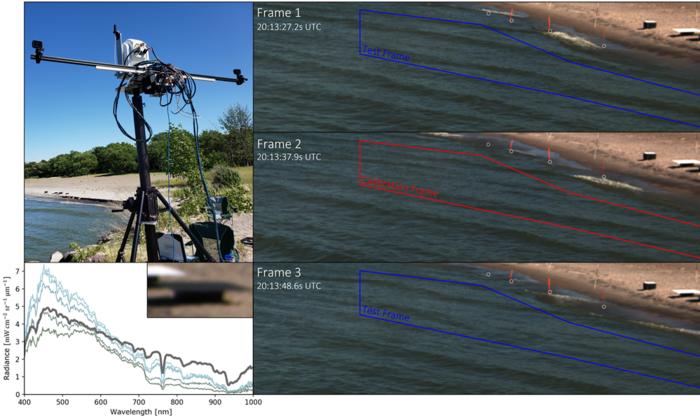In a groundbreaking advancement for remote sensing technology, researchers at the Chester F. Carlson Center for Imaging Science at the Rochester Institute of Technology have developed an innovative bimodal video imaging platform. This novel system integrates a 371-band hyperspectral imaging spectrometer with a traditional RGB video camera to create a cutting-edge solution that promises to enhance our ability to monitor and analyze dynamic natural water scenes effectively. By bridging the gap between high-cost hyperspectral technology and the more accessible RGB video technology, this platform presents an exciting opportunity for researchers and environmentalists alike.
Hyperspectral imaging, often termed imaging spectroscopy, has revolutionized the way we perceive and analyze materials across the electromagnetic spectrum. By capturing a spectrum for each pixel in an image, HSI enables researchers to identify materials based on their unique spectral signatures with unprecedented precision. This capability supports a plethora of Earth remote sensing applications including automated classification, abundance mapping, and estimation of various physical and biological properties. These properties could range from soil moisture and sediment density to critical concerns like water quality and biomass.
In the research published in the Journal of Applied Remote Sensing, the innovative bimodal platform pioneered by Chris H. Lee and his team illustrates a significant step toward overcoming these challenges. The team showcased their proof-of-concept by capturing detailed video data of the scenic Lake Ontario shoreline in Hamlin Beach State Park, Rochester, New York. By developing a novel workflow, they successfully linked the reflectance data captured from the hyperspectral imaging spectrometer with corresponding frames from the RGB video, thereby enabling predictions of hyperspectral imagery from traditional video data.
To facilitate this groundbreaking work, the team utilized a Headwall Hyperspec micro-High Efficiency imaging spectrometer in low-rate video mode, paired with a widely available GoPro Hero 8 Black camera. The researchers maximized the operational limits of these systems, capturing video data at impressive speeds in the order of a few milliseconds. Their ability to correlate RGB and hyperspectral data in both temporal and spatial dimensions marked a significant achievement in the realm of remote sensing.
In evaluating the accuracy of their predictive workflow, the researchers conducted exhaustive comparisons between the predicted hyperspectral reflectance and the measured values, meticulously correcting for any sensor-related and atmospheric effects that might skew results. Their findings revealed that while 95% of the water scene’s reflectance was accurately predicted within a mere 2% absolute reflectance in the visible spectrum, the performance faltered when they delved into the near-infrared range. Here, they discovered significantly higher errors, with normalized residual errors reaching up to 90% for 95% of the scene. The team’s conclusion attributed these discrepancies to the limited spectral data inherent in RGB video, particularly in shallow water conditions.
Lee remarked on the promising aspects of their findings, noting that the project’s successes hint at the feasibility of predicting hyperspectral frames from RGB video with reasonable accuracy in the visible wavelength range. However, he acknowledged that the drop in performance at longer wavelengths stresses the necessity for broader spectral coverage than that provided by traditional RGB data. This revelation underpins the ongoing need for advanced sensors capable of capturing a more comprehensive spectral range.
Looking forward, Lee expressed his enthusiasm about potential developments for the bimodal imaging platform. He emphasized a keen interest in aligning and calibrating both the spectrometer and the camera’s fields of view with greater precision. Furthermore, the team plans to delve into creating more sophisticated prediction models to enhance the accuracy and reliability of their results. These future improvements dwell in the hope of transforming how we monitor our environments and support essential ecological assessments.
By integrating cost-effective RGB cameras with state-of-the-art hyperspectral technology, this new innovative platform opens a myriad of possibilities for more accessible environmental monitoring. As the technology matures, its applications may extend across various fields, from critical water quality assessments to vegetation analysis and beyond, fostering a deeper understanding of our natural ecosystems and aiding in the management of our planet’s resources.
This investigation illustrates a compelling example of how the integration of different imaging modalities can harness the strengths of each technology to produce superior results. By enhancing our ability to capture and interpret critical environmental data, this research signifies a critical step forward in the evolution of remote sensing technologies. The collaborative efforts of researchers, engineers, and environmental scientists will only continue to yield exciting advancements as new methodologies emerge.
As we move forward into an era that increasingly values data-driven decision-making in environmental management, applications of this innovative imaging platform could very well play a pivotal role in decision-making processes. Researchers must continue to explore the synergies between diverse imaging technologies to create tools that not only provide results but also do so in a more efficient and cost-effective manner.
In summary, the developments outlined in this research depict a renaissance for hyperspectral imaging technology, showcasing its immense transformative potential when combined with widely used RGB video acquisition. This dual approach acknowledges the strengths present in both modalities, paving the way for fresh perspectives and insights into a multitude of environmental monitoring applications. Ultimately, as this bimodal imaging technology continues to evolve, it stands poised to enhance our understanding of significant environmental dynamics.
Subject of Research: Bimodal video imaging platform integrating hyperspectral imaging and RGB video technology.
Article Title: Coordinating high-resolution hyperspectral and RGB video acquisition of dynamic natural water scenes
News Publication Date: 19-May-2025
Web References: Journal of Applied Remote Sensing
References: DOI 10.1117/1.JRS.19.024507
Image Credits: Credit: The Authors/10.1117/1.JRS.19.024507.
Keywords
Hyperspectral imaging, Remote sensing, RGB video acquisition, Environmental monitoring, Water quality assessment, Imaging technology, Bimodal imaging platform.
Tags: accessible hyperspectral applicationsbimodal imaging technologycost-effective imaging systemsdynamic natural scene analysisEarth observation techniquesenvironmental monitoring solutionshyperspectral imaging advancementsimaging spectroscopy breakthroughsremote sensing innovationsRGB video integrationspectral signature analysiswater quality assessment technologies





